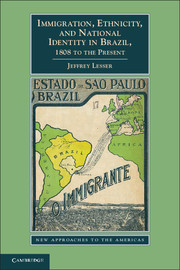Book contents
- Frontmatter
- Contents
- List of Figures, Tables, and Documents
- Acknowledgments
- Chapter 1 Creating Brazilians
- Chapter 2 From Central Europe and Asia
- Chapter 3 Mass Migrations, 1880–1920
- Chapter 4 The Creation of Euro-Brazilian Identities
- Chapter 5 How Arabs Became Jews, 1880–1940
- Chapter 6 Asianizing Brazil
- Epilogue
- Historiographical Essay
- Index
- References
Chapter 4 - The Creation of Euro-Brazilian Identities
Published online by Cambridge University Press: 05 February 2013
- Frontmatter
- Contents
- List of Figures, Tables, and Documents
- Acknowledgments
- Chapter 1 Creating Brazilians
- Chapter 2 From Central Europe and Asia
- Chapter 3 Mass Migrations, 1880–1920
- Chapter 4 The Creation of Euro-Brazilian Identities
- Chapter 5 How Arabs Became Jews, 1880–1940
- Chapter 6 Asianizing Brazil
- Epilogue
- Historiographical Essay
- Index
- References
Summary
GALLEGO: “ Foreigner, gringo”
From Felisbelo da Silva (Police Investigator), Dicionário de Gíria [Dictionary of slang] (São Paulo: Editora Prelúdio, 1974), 62One of the great stories of the invention of national identities comes in the form of a conversation that probably never took place. “We made Italy, now we have to make Italians,” said (or is said to have said) Massimo D’Azeglio, an aristocratic statesman and novelist, to Giuseppe Garibaldi, another statesman whose military exploits ranged from Italy to Uruguay to Brazil. Yet “Italian,” like other emerging national identities in the nineteenth and twentieth centuries, was not just generated at home; it was also formed abroad. Immigrants to the Americas did not simply arrive labeled as Italian, Spanish, Portuguese, Japanese, Syrian, or Korean. They became actors who imbued these words with new meanings. In Brazil, like elsewhere, new national identities sat alongside region, class, religion, and gender as characteristics by which people defined themselves.
Creating new identities was only one of the experiences of immigrants to Brazil. Another was social and cultural discrimination, and this led many to try to separate themselves from the Afro-Brazilians with whom they shared labor, residential, and social spheres. European immigrants feared being placed in a nonwhite racial category and often treated Afro-Brazilians disrespectfully, an attitude that blacks rejected. Immigrant relations with natives meant that whiteness, even when it was not the major component of national identity in their birthplace, became salient in Brazil. The constant tension among immigrants, their bosses, and nonwhite natives melded with identities inspired by the Old World.
- Type
- Chapter
- Information
- Publisher: Cambridge University PressPrint publication year: 2013



